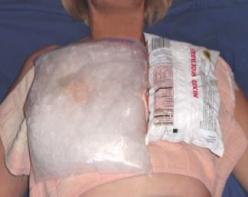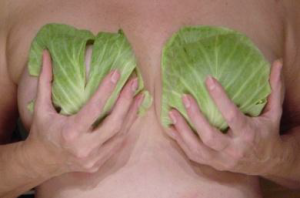Information for breastfeeding families
 Breastmilk usually “comes in” sometime during the first week after delivery. This means your milk changes from colostrum, or early milk, to mature milk. Your body may make more than your baby needs during this period and it is easy to become overly full.
Breastmilk usually “comes in” sometime during the first week after delivery. This means your milk changes from colostrum, or early milk, to mature milk. Your body may make more than your baby needs during this period and it is easy to become overly full.
To prevent engorgement:
• Start early, begin feeding soon after delivery
• Nurse frequently, about 8-12 times per day around the clock
• Make sure your baby latches-on well so he will empty your breasts effectively.
• Keep your baby actively nursing throughout the feeding
• Do not skip feedings or give formula feedings during the first several weeks.
For moderate engorgement:
(Your breasts are as firm as the tip of your nose)
• Apply warmth before feedings to soften the breast and encourage the let-down reflex.
• Stand in the shower and let warm water run over your breasts. This will feel good and encourage leaking.
• Do some gentle breast massage. Make circular motions in small areas with your finger tips and move your hand all around the breast. Then stroke from the outer breast toward the nipple.
• Watch this excellent video of hand expression of breastmilk http://newborns.stanford.edu/Breastfeeding/HandExpression.html
• Apply cold after feedings to reduce the swelling and provide comfort. You can use ice packs or bags of frozen vegetables wrapped in a light towel. Apply for 10 – 20 minutes.
For extreme engorgement:
(Your breasts feel as hard as your forehead)
• Apply cold to the breasts, no heat. This will reduce swelling, slow re-filling of the breasts and provide some comfort.
• Lying on your back helps the excessive fluid in your breasts be reabsorbed by your body.
• Apply cold as previously discussed.
• Cabbage leaves may be applied to the breasts before feedings to reduce swelling. Although this may sound like an unusual treatment, many women have found it effective in relieving the pain and fullness of engorgement. Place the chilled cabbage leaf in your bra for 15-30 minutes 2-3 times per day or until your breasts begin to soften. Not more. More can reduce your milk supply. Do not use cabbage applications if you are allergic to cabbage or you develop a skin rash.
• If latch-on is difficult at the beginning of a feeding because of the fullness, you can use hand expression to make your nipples graspable or use a breast pump for a few minutes. Hand expression may work best at this time.
• If your baby doesn’t empty your breasts sufficiently during feedings or only feeds on one breast, you may use hand expression or a breast pump after feedings for a day or two. It is important to treat engorgement before your breasts become very full and painful. This back pressure on the milk producing cells in your breast can damage them and reduce your over-all milk supply.
• If, despite using these methods, you cannot obtain relief, seek help from a lactation consultant or other knowledgeable health care provider.


